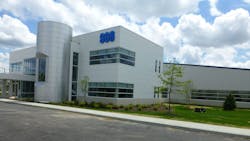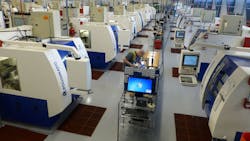Working with High School Students, and Other Wisdom from a Super-Trainer
You can tell after about a minute of talking to Gary Miller that he’s a good trainer. He’s thoughtful, direct, well-spoken. He listens closely but when it’s his turn to speak, he doesn’t fumble around for words. His voice is full of expression, but in a quiet way—he doesn’t run anybody over with his approach.
Miller, who 26 years ago started on the floor running the machines, is now director of training and occupational development at Kyocera SGS Precision Tools (KSPT), a cutting tool manufacturer in located Munroe Falls Ohio, a tiny suburb near Akron. He’s busy in his duties: the company has a state-certified four-year apprenticeship program, an on-site training center for employees with Tooling U classes and other professional development offerings, and work-study internships for high school students that can lead to apprentice certification and beyond.
KSPT* has a full-time workforce of 269. At many manufacturers of that size, having a full-time education director on staff is considered an out-of-reach luxury. But the culture of knowledge and continuous improvement is part of this company's identity, its sales pitch even. Its website extols the expertise of its workforce, from machinists to customer service people with specialized tooling knowledge: “Our own associates, after special training, lead classes that focus on improving interpersonal skills, solving problems as a team, and developing excellence,” reads one passage. “We also ‘grow our own,’ developing specialized technicians in a certified apprentice program recognized by the U.S. Department of Labor.”
KSPT's focus on internships and apprenticeship has helped it avoid a “silver tsunami” of workers retiring with no one to replace them. Its workforce overall has gotten younger: the average age of KSPT's workers was 47 in 2009. Today, it has dropped to 42.
With the U.S. unemployment rate at record lows and the skills gap in manufacturing not showing any signs of abating, tapping into the workforce at the high school level is looking like a more and more attractive proposition. But it’s not an easy one; it takes both legwork and handholding. Here, Miller, who started KSPT's high school internship program a few years ago, when the company was called SGS (Kyocera acquired it in 2016), shares his best practices for building such a program.
1. Talk to Lots of High School Classes
Miller racks up a lot of miles speaking to students about machining careers. He makes the rounds of nearby high schools, talking to shop, math and career classes. His goal is to mentor the students. He brings examples of the precision tooling KSPT makes, and explains what the machinists do, but doesn’t push the brand or try to sell students on working for his company.
“I’ve been to some things where the representative from a company says their name a half million times,” he says. “We don’t do that. It’s basically to help the kids.”
Still, interns tend to come from the classes Miller visits—they’re the kids who walk up to chat after his presentation, ready with questions and inquiries about job opportunities. Miller landed a “real gem” of an intern in a kid who was working at McDonald’s but wanted something more career-oriented for the summer. Along with initiative, the young man had high scores on a pre-employment math, mechanical aptitude and problem-solving test that Miller administers during his visits. (The tests give kids an idea of where they need to be to pursue the skilled trades.)
“I said, ‘We’d love to have you as an intern,’” Miller recalls. “And two weeks later, he was working for us.’”
2. Look for Soft Skills, Maturity
Miller says he typically can tell during interviews whether kids have the maturity for the job. Sometimes, they quibble with the hours, saying they can’t work evenings or Friday nights because they need to spend time with friends. Or they’re overly laid back and informal. The young man who answered the question, “Tell me about yourself” by leaning back in his chair and uttering, “I’m cool. I’m cool,” didn’t get an offer.
“You can train skills,” observes Miller. “But attitude and willingness to work—you can’t teach that.” One of Miller’s school presentations covers making a good impression in a job interview. “I let them know, ‘At the very end of your interview, when they ask do you have any questions, you should always have questions. And you should even ask them all through the interview. You should study the company, study the3. Pay Well
In state where the minimum wage is $8.15, high school kids are often surprised to hear they will earn in the neighborhood of $14 an hour, says Miller. If they work second shift, they also earn shift differential. Interns at KSPT work 29 hours per week or less, just under the amount where the Affordable Care Act requires employer-sponsored healthcare for part-time employees.
4. Give the Parents a Tour, Too
During the hiring process, Miller tells recruits that he wants their parents to see the plant, and to introduce them to their child’s coaches. “I’ll take them on a tour that you’re not a part of,” he tells them, taking into account adolescents’ low tolerance for embarrassment, “and I promise I won’t tell your co-workers that they’re your mom and dad.”
By law, minors can’t work in the plant without their parents’ OK. The tour helps dispel misconceptions. “We feel that parents have a lot to do with what their kids are going to be doing,” Miller reflects. “And a lot of the parents think of manufacturing as their grandpa’s manufacturing job. One of those where you take off your glasses at the end of your shift and that’s the only [clean] part of your face. … That’s actually a coal mine.”
Miller understands where the attitude is coming from because he hails from the days when manufacturing was widely considered a fallback job for academic losers. “I didn’t get good grades at all,” he says of his high school years. “I was a C and D student a maximum because I didn’t apply myself. I went to my guidance counselor when I was in tenth grade, talking about careers. He said, ‘Your grades aren’t very good. … So maybe all you’re going to be able to do is manufacturing.’”
“So back then, manufacturing was the consolation prize. It’s not a consolation prize.”
Later, another teacher saw his potential, and made an impression that was a powerful influence on Miller’s vocation—that one person who’s willing to take the time can make a difference.
“He turned me around and said ‘You can do whatever you want to do. If you wanted to get good grades, you could get good grades.’ And then for some reason he stuck with me, and from that point on I was on the merit roll. His name was Mr. Redding, and I’ll never forget him as long as I live.”
5. Age Matters
KSPT's interns are typically at least 17, because they can run the machines “like anybody else would,” says Miller. Labor laws are more restrictive for 15 and 16-year-olds, and with fewer job duties, the training loses its punch.
“It’s really funny because every [kid] I’ve ever talked to says, ‘If I come and work for you, I’m not going to be sweeping the floor, am I?’ ‘Cause everybody thinks that’s what their job is,” Miller says. “I say, ‘No you’re going to be working in our research and development department. I want you to learn about the business, about the tools.’”
6. Have a Clear Path
Interns and apprentices complete a 90-day training period, after which KSPT and the trainee decide whether the job is a good fit and to go forward with the hiring process. Around 90% of the time, that’s the case. KSPT also offers a four-year apprenticeship program, which features both on-the-job training and technical studies at Stark State Community College. Once they graduate from high school, interns can enter the apprenticeship program. “Our apprenticeship program is 100% paid for,” says Miller. “We pay for books, parking, classes—everything.”
Those who choose to continue their studies at Stark State and earn an associate's degree receive tuition reimbursement as well, with a sliding scale based on the grade they earn. If they get an A, the class is 100% paid for.“In the years I’ve run the training program, I’ve never turned anyone down for continuing their education,” says Miller. “When you work with a company that supports people’s education, not only are they going to be able to go to college, they’re going to be able to get it mostly paid for. What a great thing.”
7. Help Out Others
Miller believes that a rising tide lifts all boats. He’s on the workforce development committee at the Manufacturing and Advocacy Growth Network (MAGNET) in Ohio, a Manufacturing Extension Partnership affiliate. At Stark State College, he’s on the applied industrial technology advisory council. And he’s open to sharing what he’s learned with other manufacturers. “We actually helped another [machine shop] right up the street,” he says. “They wrote me an email asking about our apprenticeship program and how it works, and I helped them develop theirs. Now their students are going down to Stark State, too.”
8. Donate Your Products
KSPT donates tooling to many schools. Usually, the teachers or principals arrange this. But one time, a kid from a New Jersey high school called up, asking if KSPT would donate a cutting tool for his high school’s Battle Bot competition. “He said,‘We’re building these robots out of titanium, so they’ll stand up to whatever anybody throws at them. But everything we’ve used to cut it breaks or dulls out real fast, and it’s no good. Do you have anything we could use to cut this?’”
Miller sent the student an KSPT-patented tool that cuts harder metal. “He wrote me back singing the praises of this tool,” he recalls. “So we donated them a bunch more. The very next year, I get a call from Cornell University. It’s the Cornell team, working on their Baja [off-road-racing] car. I said, ‘How did you get my name?’”
Turns out, it was the same kid, in college now. “From there it just snowballed because they put our logo on their car,” says Miller. “So now all the other Baja competitors are saying, ‘Hey can you donate to us?’
The gift paid off in spades. “These are our future engineers. And they’re seeing how great KSPT tools are.”
9. Make 'Field Trips and Gadgets' Your Mantra
Noting that “kids really love field trips,” Miller often follows up his class visits with plant tours. KSPT’s training center is equipped with an 86-inch SMART board, which Miller uses to teach young visitors about ISO 9000 and specialized metals measurements. “We also have a manufacturing math tool where we teach them about fractions and decimals and how to convert to metric and back,” he says. “And they really, really love that.
“A lot of times kids will say, ‘I’m learning all this math stuff and I’m never ever going to use it,’ and we show them, ‘This is how you’re going to use those math skills later on,’” says Miller. He brings in co-workers to help with the teaching. “We have fun with it—they really have a good time.”
And a Few Additional Tips for Apprenticeships …
More than 35 KSPT workers have pursued the company’s four-year apprenticeship program. Miller advises working directly with colleges and technical schools to design the curriculum rather than having the school present a ready-made template, choosing schools like community colleges where the credits can transfer if the student decides to pursue a higher degree, and training shop floor workers who are natural teachers to become apprentice trainers.
He also encourages teamwork, getting students extra help from teachers or even co-workers who might be good at trigonometry and can do some tutoring at lunch. “When they start the apprenticeship, I give them the analogy of quicksand: When you start struggling in a class, the more you struggle, the more you sink, and if you keep sinking without reaching out for a hand, you’re just going to be buried with it.”
Miller, who’s in his mid-50s and started working at SGS/KSPT in his 20s and about six years ago finally joined the ranks of his co-workers who’ve earned associate’s degrees.
“When I was growing up I couldn’t afford to go to school,” he says. “So I’m working with Stark State and the apprentices, and the gentleman I work with down there said, ‘Do you have a degree? … Well, what’s stopping you from getting a degree.’ And I didn’t have an answer.”
His degree from Stark State is in business management. “I thought, I believe in education and training, so what’s holding me back? Nothing.”
*This story originally abbreviated Kyocera SGS Precision Tools to SGS throughout; KSPT is now the correct term.
About the Author

Laura Putre
Senior Editor, IndustryWeek
As senior editor, Laura Putre works with IndustryWeek's editorial contributors and reports on leadership and the automotive industry as they relate to manufacturing. She joined IndustryWeek in 2015 as a staff writer covering workforce issues.
Prior to IndustryWeek, Laura reported on the healthcare industry and covered local news. She was the editor of the Chicago Journal and a staff writer for Cleveland Scene. Her national bylines include The Guardian, Slate, Pacific-Standard and The Root.
Laura was a National Press Foundation fellow in 2022.
Got a story idea? Reach out to Laura at [email protected]


